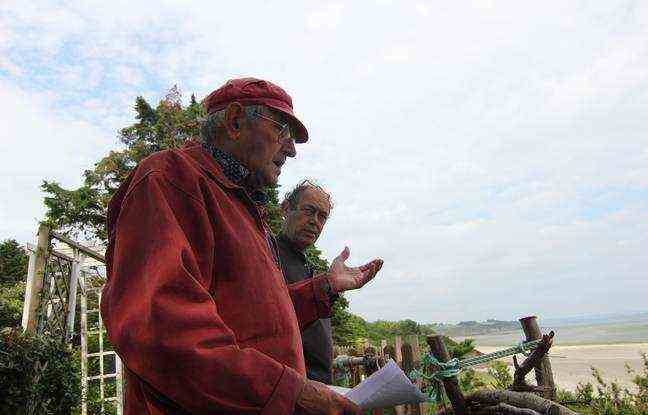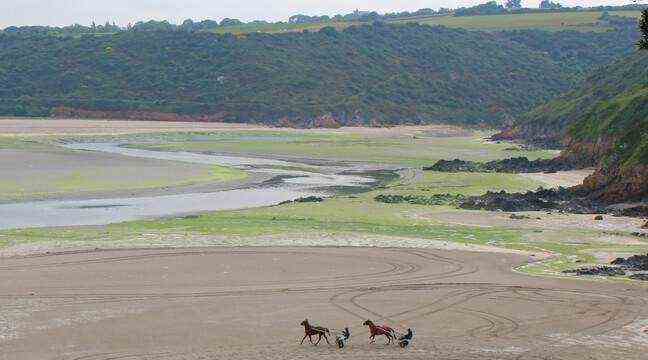Grandville beach, in Hillion, is always the scene of green algae stranding in spring. – C. Allain / 20 Minutes
- In Brittany, the subject of green algae resurfaces every spring, at the time of the first strandings on the beaches.
- A big demonstration is planned this Saturday in Lorient to ask for more effective plans of fight and open to all Brittany.
- Often singled out, farmers claim to have made efforts to limit nitrates in waterways. But in certain sectors such as the bay of Saint-Brieuc, the situation is still catastrophic.
That morning, the smell is bearable. The sand of the Grandville beach is however covered with a light green coat, turning white when it rots. As we approach, the smell becomes more pervasive. A “rotten egg” side to be wary of. In addition to being a nuisance to the eyes and an environmental scourge, green algae can be dangerous. Their putrefaction generates hydrogen sulphide, a harmful gas which has already killed horses and wild boars. And probably several men.
In the distance, an orange beacon is waving. This tractor responsible for collecting algae seems very small in the middle of the vastness of the bay. Here in Hillion, we’ve been living with green algae for decades. The subject is disturbing. One of the workers in charge of the collection comes to talk to us, he is worried about the content of our article. “We always say it’s the farmers’ fault, they’re sick of it. It’s not just that, ”he explains. We exchange cordially. A measuring device is attached to his jacket, which records the H2S content. “Sometimes it sounds when you’re in the tractor, so you get out of the area,” he explains calmly. Worried? ” Not at all “.
In 2009, Thierry Morfoisse however died at the wheel of his truck while transporting green algae in Binic, in the Côtes d’Armor. It took nearly ten years for the Social Security Court of Saint-Brieuc to recognize that it was a work accident. In 2016, a jogger died while jogging in the Anse du Gouessant, in Hillion, but no autopsy had been performed. His body must have been exhumed under pressure from the associations, reinforcing the impression that the truth was hidden.
This Saturday, a big event is organized in Lorient by the association Eau et rivières de Bretagne. A means of pressure while the theme of Breton agriculture is at the heart of the timid campaign for regional elections.
“On the beach, there is no more life. No more clams, no more bloodworms. Before, we used to go mackerel fishing but we only collect algae in our nets, so we stopped. Here, green algae are everywhere and all the time ”.
André Ollivro is one of the figures in the fight against green algae. From his shed overlooking the Grandville beach, he gets annoyed. “The seaweed on the beach is only the visible part. Go and see in the sea, it’s a soup ”.
The president of the association Halte aux marées verte shoots everyone, relying on the damning reports of the Senate and the Court of Auditors, describing the two plans of struggle as “insufficient”. The secretary of her association brandishes the modeling diagrams produced by Alain Menesguen, one of the specialists in the subject. “Even if we go down to 5 mg of nitrates in the water, we will still have algae in the bay of Saint-Brieuc”, deplores Annie Le Guilloux. Mobilized for years, the secretary of the association has already heard mayors say to her: “Green algae, we will have to learn to live with it”. André Ollivro holds up a test of a bottle of water from the village fountain. Result? A nitrate concentration loaded at 71 mg. Far from the point.
This fatalism, the mayor of the town refuses. Elected in 2014, Mickaël Cosson calls for financial resources to help with the agricultural transition and collection. “We are able to send people into space, but are we using a tractor to pick up algae on a beach?” Rather than seeing stocks spilling onto our beaches, couldn’t we pick them up at sea? “Asks the mayor of Hillion.
The latter wants to be optimistic and even defends the farmers of his town, “22% of the land has gone to organic.” Beyond the pesticides used and the dumping of slurry, one of the problems of the bay of Saint-Brieuc lies in the concentration of farms. In this watershed, there are around 1,400 farms! “The profession has made progress. It’s not huge, but nitrate levels are dropping. The problem is that that is not enough, ”regrets Yann Yobé. Breeder of cows converted to organic since 1998, the man sits on the operational committee for green algae. He cites a few convincing examples such as ground cover in autumn and winter, which prevents “leaching of the land”. For him, one of the solutions would be for each farm to be autonomous in terms of supply. Not easy in a region where we massively import Brazilian soybeans and sometimes corn from Ukraine.

This measure would result in an obvious drop in the number of animals on farms, especially in pigsties and henhouses, which are mainly responsible for nitrogen releases into nature. This solution is brandished as the only solution by environmental associations. “We have to reinvent the agricultural model, but we are not doing it! We continue to allow green algae maternities to expand. The pigsties are constantly expanding and there is nothing we can do about them, ”criticizes André Ollivro.
The extension of pigsties is raging
For years, his association has contested expansion projects. And severely criticizes the amendment tabled in 2010 by the Costa-Rican deputy Marc Le Fur made it possible to lighten the regulations applicable to installations or extensions of farms. “How can we accept that and think that we are effectively fighting against green algae? », Annoys André Ollivro. Like Eau et Rivières de Bretagne, his association pleads for an extension of the green algae plan to the entire region, and not just to the eight bays concerned by the plan. Because there are many more nitrates in the bay of Brest than in the bay of Saint-Brieuc. But at the tip of Finistère, the tides and currents take care of dispersing them.

